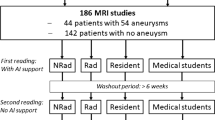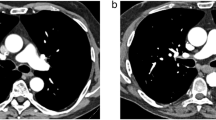Abstract
Objective
To assess radiation dose and diagnostic image quality of a low-dose (80 kV) versus a standard-dose (120 kV) protocol for computed tomography angiography (CTA) of the supra-aortic arteries.
Methods
64-slice CTA of the supra-aortic arteries was performed in 42 consecutive patients using randomly either 80 or 120 kV at 300 absolute mAs. Intravascular attenuation values, contrast-to-noise (CNR) and signal-to-noise ratio (SNR) measurements were performed at three levels. Two readers assessed image quality by using a four-point scale. The effective dose (ED) was calculated to assess the differences in radiation exposure.
Results
Intravascular attenuation values at 80 kV were higher in the common carotid artery, the carotid bifurcation and the internal carotid artery (p < 0.001). CNR and SNR differed at the internal carotid artery, with higher values in the 80-kV group (p > 0.05). Both readers revealed a significantly better image quality at 120 kV only at the common carotid artery (p < 0.001; p = 0.007). Mean ED was significantly lower at 80-kV (1.23 ± 0.09 vs. 3.99 ± 0.33 mSv; p < 0.001).
Conclusion
Tube voltage reduction to 80 kV in CTA of the supra-aortic arteries allows for significant radiation dose reduction but has limitations at the level of the common carotid artery.





Similar content being viewed by others
References
Koelemay MJ, Nederkoorn PJ, Reitsma JB, Majoie CB (2004) Systematic review of computed tomographic angiography for assessment of carotid artery disease. Stroke 35:2306–2312. doi:10.1161/01.STR.0000141426.63959.cc
Brenner DJ, Hricak H (2010) Radiation exposure from medical imaging: time to regulate? JAMA 304:208–209. doi:10.1001/jama.2010.973
Brenner DJ, Hall EJ (2007) Computed tomography–an increasing source of radiation exposure. New Engl J Med 357(22):2277–2284. doi:10.1056/NEJMra072149
Mazonakis M, Tzedakis A, Damilakis J, Gourtsoyiannis N (2007) Thyroid dose from common head and neck CT examinations in children: is there an excess risk for thyroid cancer induction? Eur Radiol 17:1352–1357. doi:10.1007/s00330-006-0417-9
Mnyusiwalla A, Aviv RI, Symons SP (2009) Radiation dose from multidetector row CT imaging for acute stroke. Neuroradiology 51:635–640. doi:10.1007/s00234-009-0543-6
Cohnen M, Wittsack HJ, Assadi S et al (2006) Radiation exposure of patients in comprehensive computed tomography of the head in acute stroke. AJNR Am J Neuroradiol 27:1741–1745
Frush DP (2002) Strategies of dose reduction. Pediatr Radiol 32:293–297. doi:10.1007/s00247-002-0684-9
Huda W, Lieberman KA, Chang J, Roskopf ML (2004) Patient size and x-ray technique factors in head computed tomography examinations. I. Radiation doses. Med Phys 31:588–594
Huda W, Scalzetti EM, Levin G (2000) Technique factors and image quality as functions of patient weight at abdominal CT. Radiology 217:430–435
Bongartz G, Golding SJ, Jurik AG, Leonardi M, van Meerten EvP (1999) European guidelines on quality criteria for computed tomography. Available at http://w3.tue.nl/fileadmin/sbd/Documenten/Leergang/BSM/European_Guidelines_Quality_Criteria_Computed_Tomography_Eur_16252.pdf. Accessed June 14, 2011
Mettler FA Jr, Bhargavan M, Faulkner K et al (2009) Radiologic and nuclear medicine studies in the United States and worldwide: frequency, radiation dose, and comparison with other radiation sources–1950–2007. Radiology 253:520–531. doi:10.1148/radiol.2532082010
Prokop M (2008) Radiation dose in computed tomography. Risks and challenges. Radiologe 48:229–242. doi:10.1007/s00117-008-1635-8
Nievelstein RA, van Dam IM, van der Molen AJ (2010) Multidetector CT in children: current concepts and dose reduction strategies. Pediatr Radiol 40:1324–1344. doi:10.1007/s00247-010-1714-7
Wintersperger B, Jakobs T, Herzog P et al (2005) Aorto-iliac multidetector-row CT angiography with low kV settings: improved vessel enhancement and simultaneous reduction of radiation dose. Eur Radiol 15:334–341. doi:10.1007/s00330-004-2575-y
Schueller-Weidekamm C, Schaefer-Prokop CM, Weber M, Herold CJ, Prokop M (2006) CT angiography of pulmonary arteries to detect pulmonary embolism: improvement of vascular enhancement with low kilovoltage settings. Radiology 241:899–907. doi:10.1148/radiol.2413040128
Watanabe H, Kanematsu M, Miyoshi T et al (2010) Improvement of image quality of low radiation dose abdominal CT by increasing contrast enhancement. AJR Am J Roentgenol 195:986–992. doi:10.2214/AJR.10.4456
Waaijer A, Prokop M, Velthuis BK, Bakker CJ, de Kort GA, van Leeuwen MS (2007) Circle of Willis at CT angiography: dose reduction and image quality–reducing tube voltage and increasing tube current settings. Radiology 242:832–839. doi:10.1148/radiol.2423051191
Huda W, Bushong SC (2001) In x-ray computed tomography, technique factors should be selected appropriate to patient size. Med Phys 28:1543–1545
Fleischmann D (2003) High-concentration contrast media in MDCT angiography: principles and rationale. Eur Radiol 13(Suppl 3):N39–N43
Nagahata M, Abe Y, Ono S et al (2007) Attenuation values of the intracranial arterial and venous vessels by bolus injection of various contrast agents: a study with a single-detector helical CT scanner. Radiat Med 25:89–93. doi:10.1007/s11604-006-0107-1
Fujikawa A, Tsuchiya K, Imai M, Nitatori T (2010) CT angiography covering both cervical and cerebral arteries using high iodine concentration contrast material with dose reduction on a 16 multidetector-row system. Neuroradiology 52:291–295. doi:10.1007/s00234-009-0611-y
Huda W, Lieberman KA, Chang J, Roskopf ML (2004) Patient size and x-ray technique factors in head computed tomography examinations. II. Image quality. Med Phys 31:595–601
Sigal-Cinqualbre AB, Hennequin R, Abada HT, Chen X, Paul JF (2004) Low-kilovoltage multi-detector row chest CT in adults: feasibility and effect on image quality and iodine dose. Radiology 231:169–174. doi:10.1148/radiol.2311030191
Author information
Authors and Affiliations
Corresponding author
Rights and permissions
About this article
Cite this article
Beitzke, D., Wolf, F., Edelhauser, G. et al. Computed tomography angiography of the carotid arteries at low kV settings: a prospective randomised trial assessing radiation dose and diagnostic confidence. Eur Radiol 21, 2434–2444 (2011). https://doi.org/10.1007/s00330-011-2188-1
Received:
Revised:
Accepted:
Published:
Issue Date:
DOI: https://doi.org/10.1007/s00330-011-2188-1




